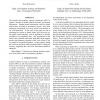Free Online Productivity Tools
i2Speak
i2Symbol
i2OCR
iTex2Img
iWeb2Print
iWeb2Shot
i2Type
iPdf2Split
iPdf2Merge
i2Bopomofo
i2Arabic
i2Style
i2Image
i2PDF
iLatex2Rtf
Sci2ools
94
Voted
ICASSP
2009
IEEE
2009
IEEE
On separating glottal source and vocal tract information in telephony speaker verification
The popular mel-frequency cepstral coefficients (MFCCs) capture a mixture of speaker-related, phonemic and channel information. Speaker-related information could be further broken down according to articulatory criteria. How these underlying components are exactly mixed in the features is not well understood. To this end, in this paper we aim at separating the spectra of glottal source and vocal tract using glottal inverse filtering, with an application to speaker recognition over telephone lines. Our experiments on the 10sec-10sec condition of the NIST 2006 SRE corpus suggest that the mel-frequency cepstrum of the voice source is not too useful for recognizing speakers. On the contrary, fusing the vocal tract spectrum with conventional MFCCs improves accuracy, suggesting that vocal tract information should be enhanced.
ICASSP 2009 | Mel-frequency Cepstral Coefficients | Signal Processing | Vocal Tract | Vocal Tract Spectrum |
| Added | 21 May 2010 |
| Updated | 21 May 2010 |
| Type | Conference |
| Year | 2009 |
| Where | ICASSP |
| Authors | Tomi Kinnunen, Paavo Alku |
Comments (0)

